by
Dara • Wednesday, April 15, 2009 •
 If you’re fortunate enough to have a job and some disposable income (yeah, right!), you won’t want to miss this weekend’s highly-anticipated Fifth On Main shopping extravaganza in Manhattan.
If you’re fortunate enough to have a job and some disposable income (yeah, right!), you won’t want to miss this weekend’s highly-anticipated Fifth On Main shopping extravaganza in Manhattan.
A soon-to-be launched e-boutique for coveted designer clothing and accessory brands, Fifth On Main will be setting up a pop-up shop in SoHo (on Friday) as a precursor to the site’s highly-anticipated launch later this spring – a genius way for all you fashion junkies to score that red-haute spring wardrobe you’ve been dreaming about before the site’s unveiled to the public.
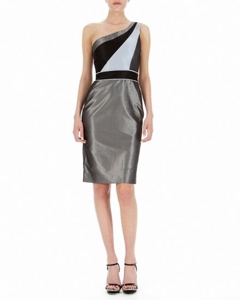 As of Friday, April 17th through Sunday, April 19th, Fifth on Main will be offering Fall/Winter, Resort and select Spring apparel and accessories at 40% – 60% off the retail prices. I repeat – 40-60% off the retail prices!
As of Friday, April 17th through Sunday, April 19th, Fifth on Main will be offering Fall/Winter, Resort and select Spring apparel and accessories at 40% – 60% off the retail prices. I repeat – 40-60% off the retail prices!
Prepare to duke-it-out with other die-hards over the mind-blowing selection of merch from Abaete (I’m loving this one-shoulder dress), Alvin Valley, Brian Reyes, Badgley Mischka, TIBI, Twelfth Street, Carmen Marc Valvo, Catherine Malandrino, Nicole Miller, Rebecca Taylor, Mint by Jodi Arnold, Theory, Chaiken and more! In case you were wondering, all the goods will be priced from $150 – $300 (reduced from $300 – $900+) – a total steal.
Some final words of wisdom: make sure to head over at least one hour before the doors are scheduled to open if you want first dibs on all the best merch. See you there!
-
The Retail Details!
- Who: Fifth On Main, a new e-commerce boutique targeting the contemporary womenswear market, launching late Spring 2009.
- What: Pop-up store holding a Fall/Winter & Resort Sample Sale + Spring Preview Sale, open to the public.
- Featured Designers: Abaete, Alvin Valley, Brian Reyes, Badgley Mischka, TIBI, Twelfth Street, Carmen Marc Valvo, Catherine Malandrino, Nicole Miller, Rebecca Taylor, Mint by Jodi Arnold, Theory, Chaiken and more!
- The Goods: 40% – 60% off retail prices!
- Even more goods: RSVP to lauren@rich-pr.com and receive an additional 10% off your total purchase!
- Where: 109 Spring Street, between Greene & Mercer, Soho, New York
- When: Friday, April 17th 10am – 8pm; Saturday, April 18th 10am – 7pm and Sunday, April 19th 10am – 7pm
by
Dara • Saturday, March 7, 2009 •
 Do to an overwhelming response following last week’s Confessions Of A “Recovering” Shopaholic post (I guess that’s good and bad), I thought I’d do us all a favor by delving a little deeper into the subject by interviewing one of the industry’s leading compulsive buying experts, Terry Shulman.
Do to an overwhelming response following last week’s Confessions Of A “Recovering” Shopaholic post (I guess that’s good and bad), I thought I’d do us all a favor by delving a little deeper into the subject by interviewing one of the industry’s leading compulsive buying experts, Terry Shulman.
As Founder of The Shulman Center For Compulsive Theft & Spending, Terry shares his personal experiences and provides thoughtful insight to questions that could help you (or those near and dear to you) to get back on the road to recovery.
FJ: Can you tell Fashion Junkie readers a little bit about your background and why you decided to establish The Shulman Center?
TS: I’ve been an attorney since 1992 and a certified social worker and addictions therapist since 1997. I have been in recovery from shoplifting addiction since 1990 and started C.A.S.A.—Cleptomaniacs And Shoplifters Anonymous in 1992. I have always been interested in addictions since my father struggled with alcoholism, gambling, and overshopping. In working with members of my support groups as well as with private counseling clients, there was a lot of money issues, spending issues, stealing issues that were not being addressed in a specialized and serious-minded way.
FJ: What kind of services do you offer at The Shulman Center?
TS: I offer professional, specialized counseling in person here in the metro-Detroit area as well as by phone. 90% of my counseling clients are phone clients. I am also set-up to do phone or video-conferencing through SKYPE. I am the author of 3 books—on shoplifting, employee theft, and compulsive shopping & spending—and offer my books as helpful tools for education and change. I direct persons to resources (books, support groups, counseling, financial services, etc.). I write articles and do interviews both in print, on radio, and on TV to educate the public. I put on seminars and speak at seminars or trainings on theft and/or spending/money issues. Finally, I do private consulting with individuals and companies about theft/spending/money issues.
FJ: How do you know if you’re a compulsive buyer? What are the typical traits/warning signs?
TS: The traits are similar to most addictions/compulsions but include:
- stress or emotional turbulence related directly or indirectly to shopping or spending;
- trouble managing debt, paying bills, etc.
- an increasing preoccupation with shopping/spending which results in changes in sleep, eating, productivity, schedule management
- arguments over money/spending with friends or family or significant others
- a loss of control over one’s limits, repeatedly breaking of promises to stop or reduce shopping/spending
- lying about what you’ve spent or where you’ve been, hiding purchases, opening up secret accounts, stealing to get money to buy things and/or pay off debt
- increase depression, anxiety, guilt, remorse, low self-image and esteem
- a pervasive feeling of pressure that something bad is going to happen
FJ: What types of people are most at risk?
TS: All people are at risk of becoming compulsive shoppers/spenders but some more than others, including:
- young people (who tend to be more image-conscious and peer group conscious and more impulsive and naïve about financial management
- persons with previous or current addictive-compulsive behaviors (there’s a tendency to switch, replace, or transfer behaviors)
- persons who are image-conscious, perfectionistic, control-oriented or persons who tend to give gifts to others excessively to win love, buy approval, attempt to avoid abandonment (co-dependents)
- parents with children (may overindulge their kids out of guilt for not giving them enough time/energy/love)
- persons with poor impulse control or with ADHD or OCD
- persons who frequent stores a lot, watch TV a lot, or are online a lot (open to more frequent advertising and messages and triggers/temptations and access to goods)
- persons who grew up either materially or emotionally deprived or persons who grew up materially spoiled or overindulged
FJ: I’ve read that people who suffer from compulsive buying disorder exhibit similar traits to that of a gambler or drug addict. Is this true and why?
TS: Yes, all addictions are similar in that “one is too many and a thousand is never enough.” Once you’re hooked, you chase that feeling of exhilaration and there’s no prolonged satisfaction. The gambler—whether she wins or loses keeps chasing the high; it’s not really about the money. Same thing for the shopper or spender—it’s no longer about the thing bought or the thing spent on; it’s the feeling of satisfaction, calmness, euphoria, completeness the shopper/spender feels for the moment.
FJ: Does the saying, “once an addict, always an addict” also apply to a compulsive buyer? Assuming this is true, what are the chances of having a relapse?
TS: I’m not dogmatic about this but tend to agree with this conventional wisdom. The interesting thing about some addictions and recovery such as with shopping/spending, sexual addiction, co-dependency, workaholism, and overeating is that we are not shooting for sustained and complete abstinence (one day at a time) as like with alcohol, drugs, shoplifting, gambling but, rather, balance and manageability. Recovering overeaters need to eat and find a new relationship to food and their bodies; sex addicts need to find a new healthy relationship to sex and sexuality; co-dependents need to learn how and when and how much to help or give to others not stop completely; workaholics need to learn balance with work, etc. So, compulsive shoppers/spenders need to learn what they are really shopping for, identify and begin to heal their core issues/wounds, and develop a rigorous recovery program of support, accountability, honesty, and filling up of their time in a healthy, productive and self-affirming way.
FJ: What are some of the treatment options for a compulsive buyer… do they really work?
TS: As with any addiction-recovery treatment strategy, success is measured one day at a time for the rest of one’s life. Some factors that add to a successful outcome are: competency of the therapist/treatment program, commitment of the client/patient, strength of the support system, medication management (if needed), degree of honesty, avoidance of triggers (negative people/places), change of lifestyle, consistent support group attendance, ongoing interest in reading books and literature about this particular subject as well as personal/spiritual growth in general, and an acceptance of recovery as ongoing rather than looking for a “cure” or endpoint.
FJ: I’m embarrassed to ask, but I have to… what are your thoughts about the movie, Confessions of A Shopaholic? Do you think Isla Fisher’s character (Becky Bloomwood) was portrayed in a realistic manner?
TS: I’ve seen the movie twice since it came out and have recently read the book as well. Of course, the book and movie are not intended as serious docu-dramas so, no, they don’t portray things realistically for the most part either in actuality or tone; things are dramatized for laughs and comedic effect. However, there were aspects both in the book and in the movie that gave a glimpse of what many “shopaholics” experience: anxiety, distraction and shame over debt; dishonesty in relationships which cause problems; humiliation; denial; attempts to minimize or excuse debt; excessive hoarding; lying and hiding and sneaking to avoid paying debts or to avoid discovery by others of the problem; a lack of ability to focus on one’s higher talents and callings; the larger familial and cultural pressures to shop, spend, and uphold an image; and many unsuccessful attempts to reduce or stop shopping/spending. So, in sum, the character in the book/movie played by Isla Fisher was mostly for comic effect but did have some moments of pathos and distress that shone through.
By the way, The Shulman Center is given a small credit at the film’s end for permission to use “Shopaholics Anonymous” for the name of support group.
FJ: With retailers’ aggressive markdowns due to the depressed economy, it almost seems justified to be a “serial shopper.” What are your thoughts on this? What can someone who suffers from compulsive buying disorder do to stay away from the so-called “danger zones” (e.g. sample sales, deep in-store discounts, etc.)
TS: One of my favorite sayings is: “you have to spend money to save money.” People with a shopping/spending problem still need to avoid the deals because they are still shopping/spending with money they usually don’t have, driving themselves deeper into debt especially when using credit cards and accounting for interest, late fees, etc.—a deal isn’t always a deal in the end. Also, what about the time, energy, and focus lost on shopping/spending on deals. You feel a momentary victory, then what? Disgusted. Running out of space and hoarding is another problem. Arguments with others about the spending and clutter kill relationships. And, in the end, nothing we can have or own (money or things) can really fill the void and make us happy. Find other creative, fulfilling and inexpensive ways to spend our time and connect and be productive.
FJ: What do you think of the growing phenomenon of luxury “flash sale” sample sites or online shopping clubs such as Gilt.com and BeyondTheRack.com? These sites have garnered a cult following for selling deeply discounted designer apparel and accessories for a limited period of time to their members.
TS: I can understand the appeal: we all like to belong to a club and feel we’re a part of something exclusive, somewhat below the radar, and who doesn’t like a great deal?! Still, what are the costs ultimately and do they outweigh the perceived benefits. Many shopaholics, once they get well, report they can’t believe how crazy, misguided in values, and out-of-control they were. The newfound peace, meaning, and self-esteem they discover are priceless.
FJ: Can you recommend any other associations, books or websites that compulsive buyers can turn to if they need help?
TS: Besides my book “Bought Out and $pent: Recovery from Compulsive $hopping and $pending” and my website shopaholicsanonymous.org, I’d recommend Debtors Anonymous meetings and “Shopaholics Anonymous” meetings online at www.yahoogroups.com. I’d also recommend the counseling work of Dr. April Benson out of New York and her new book “To Buy or Not to Buy.”
FJ: Are compulsive buying tendencies highly correlated with any particular socio-economic demographic?
TS: As stated before, anyone can become a shopaholic or compulsive shopper/spender. I’ve worked with rich and poor alike (those who shop for Chanel to Shabby-Chic). One of the ironies is that, with the fledgling economy and almost everyone tightening their financial belts, there’s been a corresponding increase in compulsive shopping/spending both among the newly afflicted as well as those previously struggling; not only are the bargains hard to resist for many but just the stress and complex emotions related to the economic woes and other related losses and uncertainties make many even more vulnerable to trying to escape reality and soothe themselves through shopping/spending which makes things even worse and, of course, a vicious cycle continues until a bottoming out financially or emotionally or both.
Do you suffer from compulsive shopping? Share your stories with the Fashion Junkie community.
by
Dara • Sunday, February 22, 2009 •
With all the hoopla surrounding the newly released film, Confessions of a Shopaholic, I thought it only fitting that I blog about the subject matter, especially given that 17.5 million Americans suffer from compulsive buying. Yes, myself included. While certainly not one of my better traits, I’m well on the road to recovery (as if I really had a choice in this economy?) and I thought I’d share some of the warning signs and preventative measures to help you or someone you know.
Just like alcohol and gambling for some, compulsive buying is an addiction and can be destructive to you and those around you… just ask my husband! “When it becomes repetitive and gets to the point where you’re actually craving it, that becomes a problem,” says Terrence Shulman, founder of The Shulman Center for Compulsive Theft & Spending.
Just so you’re aware, compulsive buying had its roots well before Sophie Kinsella’s chick lit novel became a best seller. In fact, the disorder was first identified by a German doctor in 1915 who referred to it as “oniomania” for the Greek term “onios,” which means “for sale.” Even the American Psychiatric Association is considering including compulsive buying in it’s updated manual of mental disorders.
With retailers’ aggressive discounting due to the disastrous economy, no wonder compulsive buying is even more prevalent than ever before. Everywhere I go it seems as if there’s a designer deal to be had. Even high-end department stores like Bergdorf Goodman are currently selling designer merch at discounts of up to 50% off…. something that was unheard of before. That, coupled with the recent trend of those time-sensitive luxury sample sale sites like BeyondTheRack.com and Gilt.com, serial shopping almost sounds justified.
Brave enough to ask yourself if you suffer from compulsive shopping behavior? Better ask yourself the following questions:
- Do you have a closet filled with unworn designer duds with the tags still attached, yet still feel you have nothing to wear?
- Does your monthly shoe allowance exceed your rent?
- Do you return almost everything you buy? Yes, this is still a symptom of a related disorder (a.k.a. shopping bulimia).
- When you’re feeling blue, do you seek comfort at one of the three B’s: Bloomies, Bergdorf’s or Barney’s?
- Do you hide purchases from your significant other and lie about what you spend (sorry dad, you might want to search Mom’s closet!).
- When you shop, do you feel a rush of euphoria mixed with feelings of anxiety?
If you answered yes to 3 or more of these questions, you likely have compulsive buying tendencies. For more information on symptoms and treatment, visit The Shulman Center For Compulsive Theft & Spending or shopaholicsanonymous.org
Do you suffer from compulsive shopping? Share your stories with the Fashion Junkie community.
by
Dara • Friday, February 6, 2009 •
Don’t get me wrong. I love living in the Big Apple. But having just endured several weeks of consecutive sub zero temps accompanied by snow and sleet, I’m desperate for a large dose of vitamin D. But since I can’t afford a ticket to the Caribbean anytime soon, I’ve resorted to virtual retail therapy: perusing luxury e-tailers like Net-A-Porter.com in search of colorful and flesh-baring pre-spring frocks I wish I had in my wardrobe. Admittedly, this fashion porn is self-inflicted torture, but who says a girl can’t dream every now and then, right?! But I digress. From drop-catch dhoti pants to bandage dresses to fringe-adorned footwear, Spring ‘09’s sartorial offerings are guaranteed to lift your spirits no matter how gloomy these economic times.
Hip, Hip, Harem!
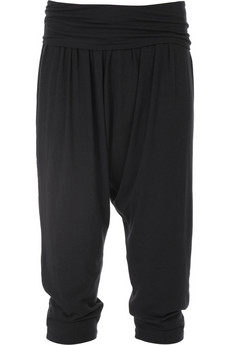 When it comes to bottoms, baggy is the buzzword of the day. The ones worth investing in for spring are Splendid’s M.C. Hammer-inspired harems (shown here). Note the characteristically low crotch (a.k.a. crap-catchers), which looks beyond smashing when paired with cutout heels and a cropped blazer. Strikingly similar to what I wore in the ‘80’s (if only I hadn’t donated ‘em all to Goodwill!), Splendid’s contemporary jersey version is undeniably comfy and cool. Plus, the fold-over waistband does wonders for concealing PMS-induced tummy bloat. Affordably priced at $115, why not treat yourself to all three hues (available in black, grey and white)… at least while they’re in stock. Better “bust a move” before they sell out! Splendid jersey harem pants, $115 at netaporter.com.
When it comes to bottoms, baggy is the buzzword of the day. The ones worth investing in for spring are Splendid’s M.C. Hammer-inspired harems (shown here). Note the characteristically low crotch (a.k.a. crap-catchers), which looks beyond smashing when paired with cutout heels and a cropped blazer. Strikingly similar to what I wore in the ‘80’s (if only I hadn’t donated ‘em all to Goodwill!), Splendid’s contemporary jersey version is undeniably comfy and cool. Plus, the fold-over waistband does wonders for concealing PMS-induced tummy bloat. Affordably priced at $115, why not treat yourself to all three hues (available in black, grey and white)… at least while they’re in stock. Better “bust a move” before they sell out! Splendid jersey harem pants, $115 at netaporter.com.
Romper Rage
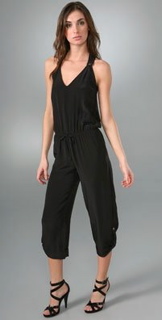 Thanks to the return of the romper, “jumping for joy” will have new meaning this spring. Also referred to as the onesie, the playsuit, the catsuit and the jumpsuit, this ultra sexy evening staple from the ‘80’s has clearly made a swift comeback. Now perfectly acceptable to don during daylight hours, this silk “I Dream Of Jeanie” jumper from Myne, which has a skin-baring V neck and gathered T strap in back (meow!), is the one on my radar screen. The only downside with this trend: it’s a total pain in the arse when you have to pee. Myne Abbie Jumpsuit, $317 at shopbop.com
Thanks to the return of the romper, “jumping for joy” will have new meaning this spring. Also referred to as the onesie, the playsuit, the catsuit and the jumpsuit, this ultra sexy evening staple from the ‘80’s has clearly made a swift comeback. Now perfectly acceptable to don during daylight hours, this silk “I Dream Of Jeanie” jumper from Myne, which has a skin-baring V neck and gathered T strap in back (meow!), is the one on my radar screen. The only downside with this trend: it’s a total pain in the arse when you have to pee. Myne Abbie Jumpsuit, $317 at shopbop.com
Bandage Dress
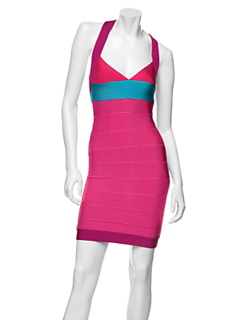 Slip into this slinky Hervé Léger bandage dress and you’ll look like you’ve just had lipo… sans the surgery. Just check out this photo of Beyoncé…not an unsightly bulge in sight?
Slip into this slinky Hervé Léger bandage dress and you’ll look like you’ve just had lipo… sans the surgery. Just check out this photo of Beyoncé…not an unsightly bulge in sight? 
 And in this photo of Victoria Beckham, her boobs and normally bony butt appear to have been given a lift. I know… it’s hard to believe that a combo of tightly woven rayon, nylon and spandex works like an instant tummy tuck!! In fact, after trying one on at Intermix, I confidently strutted around the store without having to suck in my gut. The va-va-voom neckline, criss-cross straps (in the back) and pops of fuschia, turquoise and hot pink are the pièce de resistance. Although a $990 price tag may seem unconscionable, Leger’s iconic curve-inducing bandage dress is still considerably cheaper than a trip to your plastic surgeon. Available at intermixonline.com
And in this photo of Victoria Beckham, her boobs and normally bony butt appear to have been given a lift. I know… it’s hard to believe that a combo of tightly woven rayon, nylon and spandex works like an instant tummy tuck!! In fact, after trying one on at Intermix, I confidently strutted around the store without having to suck in my gut. The va-va-voom neckline, criss-cross straps (in the back) and pops of fuschia, turquoise and hot pink are the pièce de resistance. Although a $990 price tag may seem unconscionable, Leger’s iconic curve-inducing bandage dress is still considerably cheaper than a trip to your plastic surgeon. Available at intermixonline.com
Fringe Benefits
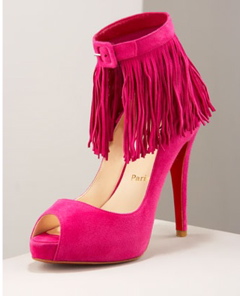 Saddle up, sisters! The new frontier in fashion for Spring ‘09 is all about… the “fringe.” Aside from the usual suspects like vintage-inspired suede jackets and vests, these trendy tassels can also be found dangling from a host of designer threads such as this Foley & Corinna nude flapper dress, V-neck tanks, satchels (this purple Botkier is my personal fave) and even shoes, like these jaw-dropping Christian Louboutin peep-toe pumps (shown here). Don’t you just love how the (suede) strands gracefully drape around the ankles but still reveal a hint of skin? An added bonus is their concealed platform, which enables even the spazziest of fashionistas to balance despite the teetering 4 7/10” heel. Available in midnight black and this bold magenta hue for the mind-boggling price of $1,095 at BergorfGoodman.com. Recessionistas don’t despair… betcha it’s only a matter of time ‘til Topshop knocks ‘em off.
Saddle up, sisters! The new frontier in fashion for Spring ‘09 is all about… the “fringe.” Aside from the usual suspects like vintage-inspired suede jackets and vests, these trendy tassels can also be found dangling from a host of designer threads such as this Foley & Corinna nude flapper dress, V-neck tanks, satchels (this purple Botkier is my personal fave) and even shoes, like these jaw-dropping Christian Louboutin peep-toe pumps (shown here). Don’t you just love how the (suede) strands gracefully drape around the ankles but still reveal a hint of skin? An added bonus is their concealed platform, which enables even the spazziest of fashionistas to balance despite the teetering 4 7/10” heel. Available in midnight black and this bold magenta hue for the mind-boggling price of $1,095 at BergorfGoodman.com. Recessionistas don’t despair… betcha it’s only a matter of time ‘til Topshop knocks ‘em off.
Crazy Cut Outs
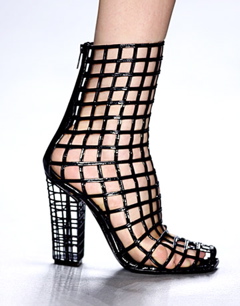 Not that I have the disposable income to invest in any luxury designer items at the moment, but if I did, I’d definitely snap up these sizzling Yves Saint Laurent bondage-inspired cage boots, which sell for a steep $1,400. Aside from their obvious cool factor, Laurent’s luxe foot jewels let your toesies breathe so you needn’t worry about athlete’s foot and the accompanying stink. Buyers beware: with a stacked heel this exposed, you’d better avoid wearing ‘em whilst walking Fido in the park, if you know what I mean. Available at luisaviaroma.com
Not that I have the disposable income to invest in any luxury designer items at the moment, but if I did, I’d definitely snap up these sizzling Yves Saint Laurent bondage-inspired cage boots, which sell for a steep $1,400. Aside from their obvious cool factor, Laurent’s luxe foot jewels let your toesies breathe so you needn’t worry about athlete’s foot and the accompanying stink. Buyers beware: with a stacked heel this exposed, you’d better avoid wearing ‘em whilst walking Fido in the park, if you know what I mean. Available at luisaviaroma.com
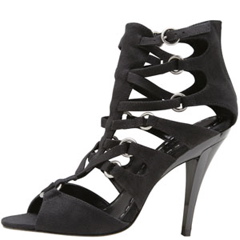 For recessionistas in need of a more wallet-friendly option, you can’t go wrong with these fierce $38 (I repeat, $38!) Abaeté for Payless gladiator sandals. Made from real suede, these cheap, yet chic shoes feature a padded footbed for added comfort and a convenient back zip. Throw ‘em on with a sexy catsuit and you’ll clearly have a “jump” start on your spring wardrobe. Happy shopping!
For recessionistas in need of a more wallet-friendly option, you can’t go wrong with these fierce $38 (I repeat, $38!) Abaeté for Payless gladiator sandals. Made from real suede, these cheap, yet chic shoes feature a padded footbed for added comfort and a convenient back zip. Throw ‘em on with a sexy catsuit and you’ll clearly have a “jump” start on your spring wardrobe. Happy shopping!
I’m curious… would you break the bank on any of these designer luxury items or are you putting the kibosh on frivolous purchases altogether due to the recession? C’mon, don’t be shy… share your thoughts with the Fashion Junkie community!
by
Dara • Wednesday, December 17, 2008 •
 As a bonafide beauty junkie, I’ve come across a lot of “eye-opening” gadgets in my time, but nothing even comes close to Lancôme Ôscillation – the world’s first battery-operated, vibrating mascara wand.
As a bonafide beauty junkie, I’ve come across a lot of “eye-opening” gadgets in my time, but nothing even comes close to Lancôme Ôscillation – the world’s first battery-operated, vibrating mascara wand.
I know, you’re probably wondering: “why on earth does anyone need a $34 dollar gizmo like this added to their everyday beauty routine?” For starters, this revolutionary black mascara is made from an ultra-moisturizing formula that has incredible staying power. But the biggest benefit is the built-in miniaturized motor that oscillates 7000 times per minute, giving you controlled and evenly defined eyelash coverage that doesn’t clump! The vibrating wand extends, separates and voluminizes lashes in just three quick and easy steps:
Step 1: Simply unscrew the cap and press the little button to activate the vibrating wand. You’ll hear a buzzing nose that sounds like an electric toothbrush. Make sure to hold the button down during application for a continuous vibration.
Step 2: Wipe the wand with a piece of Kleenex to remove excess mascara. I always do this before application for a more natural look.
Step 3: Place the wand at the base of the lash line, hold it steady and slowly glide it upwards from root to tip. There’s no need to zig-zag or use fast little strokes – Lancôme Ôscillation does all the work! Count up to five seconds (for each application) to ensure the best results. Notice how your upper lashes are thicker and longer… without any clumps!
Keep in mind: one quick coat is all you need for gorgeous, longer-looking and natural lashes. For a more dramatic result, simply apply another 2-3 coats. Just make sure to wait at least 30 seconds for the mascara to dry. You can also add the mascara to your lower lashes to really make your eyes pop.
Try Lancôme Ôscillation and you’ll never have to fuss with an eyelash curler, falsies or bleaching agents again! Plus, it’s goof-proof, makes for a perfect stocking stuffer and is just plain fun!
Buy your tube of Lancôme Ôscillation at Sephora.com while supplies last.
 If you’re fortunate enough to have a job and some disposable income (yeah, right!), you won’t want to miss this weekend’s highly-anticipated Fifth On Main shopping extravaganza in Manhattan.
If you’re fortunate enough to have a job and some disposable income (yeah, right!), you won’t want to miss this weekend’s highly-anticipated Fifth On Main shopping extravaganza in Manhattan. As of Friday, April 17th through Sunday, April 19th, Fifth on Main will be offering Fall/Winter, Resort and select Spring apparel and accessories at 40% – 60% off the retail prices. I repeat – 40-60% off the retail prices!
As of Friday, April 17th through Sunday, April 19th, Fifth on Main will be offering Fall/Winter, Resort and select Spring apparel and accessories at 40% – 60% off the retail prices. I repeat – 40-60% off the retail prices!


























